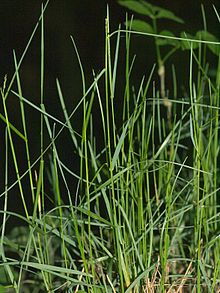Poa nemoralis
| Poa nemoralis | |
|---|---|
 |
|
| Scientific classification | |
| Kingdom: | Plantae |
| (unranked): | Angiosperms |
| (unranked): | Monocots |
| (unranked): | Commelinids |
| Order: | Poales |
| Family: | Poaceae |
| Genus: | Poa |
| Species: | P. nemoralis |
| Binomial name | |
|
Poa nemoralis L. |
|
| Synonyms | |
|
Agrostis alba L. |
|
Agrostis alba L.
Poa nemoralis, the wood bluegrass, is a perennial plant in the Poaceae family. The late-growing grass is fairly nutritious for livestock, which feed on it in the autumn.
It is often found in forests and grows up to half a metre tall. It is generally distributed in Britain in dry woods, thickets and shady hedge banks on well drained soils. It is an introduced species in North America.
It forms loose tufts, and is of a more delicate, slender appearance than other meadow grasses.
It is slightly creeping. The leaves are narrow, tapering to a point. The ligules are short (0.5 mm).
The stem is slender, 30–60 cm high. The panicle is slender, loose and branched.
The spikelets are few and egg shaped. They have one to five flowers. It is in flower from June to August.
Because of the characteristic lamina, similar to a stretched out arm, it is sometimes called "Wegweisergras" (signpost grass) in Germany.
...
Wikipedia
